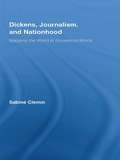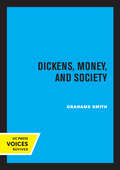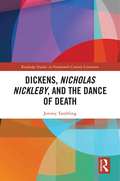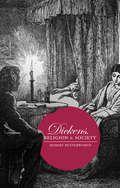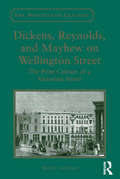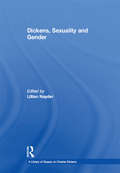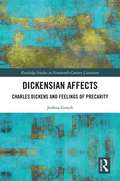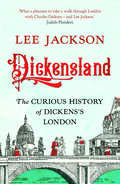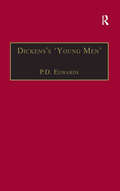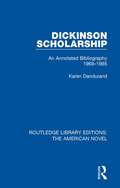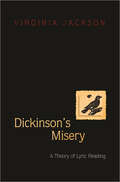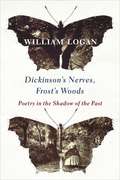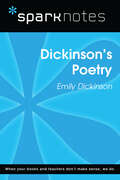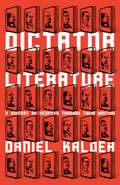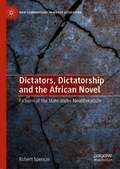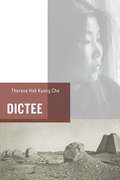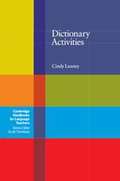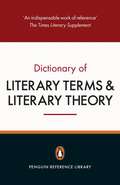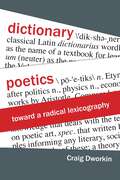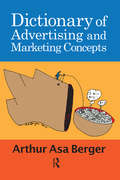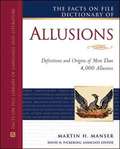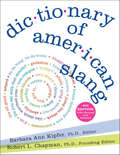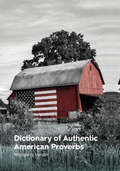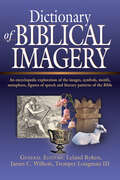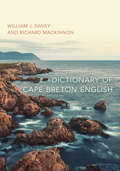- Table View
- List View
Dickens, Journalism, and Nationhood: Mapping the World in Household Words (Studies in Major Literary Authors)
by Sabine ClemmDickens, Journalism, and Nationhood examines Charles Dickens’ weekly family magazine Household Words in order to develop a detailed picture of how the journal negotiated, asserted and simultaneously deconstructed Englishness as a unified (and sometimes unifying) mode of expression. It offers close readings of a wide range of materials that self-consciously focus on the nature of England as well as the relationship between Britain and the European continent, Ireland, and the British colonies. Starting with the representation and classification of identities that took place within the framework of the Great Exhibition of 1851, it suggests that the journal strives for a model of the world in concentric circles, spiraling outward from the metropolitan center of London. Despite this apparent orderliness, however, each of the national or regional categories constructed by the journal also resists and undermines such a clear-cut representation.
Dickens, Money, and Society
by Grahame SmithThis title is part of UC Press's Voices Revived program, which commemorates University of California Press’s mission to seek out and cultivate the brightest minds and give them voice, reach, and impact. Drawing on a backlist dating to 1893, Voices Revived makes high-quality, peer-reviewed scholarship accessible once again using print-on-demand technology. This title was originally published in 1968.
Dickens, Nicholas Nickleby, and the Dance of Death (Routledge Studies in Nineteenth Century Literature)
by Jeremy TamblingThis study of Nicholas Nickleby takes the Dickens novel which is perhaps the least critically discussed, though it is very popular, and examines its appeal and its significance, and finds it one of the most rewarding and powerful of Dickens’s texts. Nicholas Nickleby deals with the abduction and destruction of children, often with the collusion of their parents. It concentrates on this theme in a way which continues from Oliver Twist, describing such oppression, and the resistance to it, in the language of melodrama, of parody and comedy. With chapters on the school-system that Dickens attacks, and its grotesque embodiment in Squeers, and with discussion of how the novel reshapes eighteenth century literary traditions, and such topics as the novel’s comedy, and the concept of the ‘humorist’; and ‘theatricality’ and its debt to Carlyle,, the book delves into the way that the novel explores madness within the city in those whose lives have been fractured, or ruined, as so many have been, and considers the symptoms of hypocrisy in the lives of the oppressors and the oppressed alike; taking hypocrisy as a Dickensian subject which deserves further examination. Dickens, Nicholas Nickleby, and the Dance of Death explores ways in which Dickens draws on medieval and baroque traditions in how he analyses death and its grotesquerie, especially drawing on the visual tradition of the ‘dance of death’ which is referred to here and which is prevalent throughout Dickens’s novels. It shows these traditions to be at the heart of London, and aims to illuminate a strand within Dickens’s thinking from first to last. Drawing on the critical theory of Walter Benjamin, Freud, Nietzsche and Marx, and with close detailed readings of such well-known figures as Mrs Nickleby, Vincent Crummles and his theatrical troupe, and Mr Mantalini, and attention to Dickens’s description, imagery, irony, and sense of the singular, this book is a major study which will help in the revaluation of Dickens’s early novels.
Dickens, Religion and Society
by Robert ButterworthDickens, Religion and Society examines the centrality of Dickens's religious attitudes to the social criticism he is famous for, shedding new light in the process on such matters as the presentation of Fagin as a villainous Jew, the hostile portrayal of trade unions in Hard Times and Dickens's sentimentality.
Dickens, Reynolds, and Mayhew on Wellington Street: The Print Culture of a Victorian Street (The Nineteenth Century Series)
by Mary L. ShannonA glance over the back pages of mid-nineteenth-century newspapers and periodicals published in London reveals that Wellington Street stands out among imprint addresses. Between 1843 and 1853, Household Words, Reynolds’s Weekly Newspaper, the Examiner, Punch, the Athenaeum, the Spectator, the Morning Post, and the serial edition of London Labour and the London Poor, to name a few, were all published from this short street off the Strand. Mary L. Shannon identifies, for the first time, the close proximity of the offices of Charles Dickens, G.W.M. Reynolds, and Henry Mayhew, examining the ramifications for the individual authors and for nineteenth-century publishing. What are the implications of Charles Dickens, his arch-competitor the radical publisher G.W.M. Reynolds, and Henry Mayhew being such close neighbours? Given that London was capital of more than Britain alone, what connections does Wellington Street reveal between London print networks and the print culture and networks of the wider empire? How might the editors’ experiences make us rethink the ways in which they and others addressed their anonymous readers as ’friends’, as if they were part of their immediate social network? As Shannon shows, readers in the London of the 1840s and '50s, despite advances in literacy, print technology, and communications, were not simply an ’imagined community’ of individuals who read in silent privacy, but active members of an imagined network that punctured the anonymity of the teeming city and even the empire.
Dickens, Sexuality and Gender (A Library of Essays on Charles Dickens)
by Lillian NayderThis volume of essays examines Dickens's complex representations of sexuality and gender as well as his use of gender ideologies and sexual and gender differences over the course of his literary career, from his first sketches and early novels to his late works of fiction. The essays approach gender issues in Dickens's writing by focusing on a number of topics: his treatment of gender ideals and transgressions; the intersections and displacements among gender, class and race; the ties between gender and the body, and among gender, voice and language; his depiction of the homosocial and the homoerotic; and the relation between gender and the law. The essays provide an introduction to the most recent approaches to Dickens's fiction in addition to those now considered classic, draw on queer theory and also feature a variety of methodologies, ranging across feminist, historicist and psychoanalytic methods of interpretation. The collection represents the best of previously published research by Dickens's scholars and illuminates for students and scholars alike the meaning of gender in such novels as The Pickwick Papers, Dombey and Son, and Our Mutual Friend.
Dickensian Affects: Charles Dickens and Feelings of Precarity (Routledge Studies in Nineteenth Century Literature)
by Joshua GoochIn Dickensian Affects: Charles Dickens and Feelings of Precarity, Joshua Gooch argues that Dickens’s novels offer models of feeling that illuminate the dissensions that accompany life’s precariousness under capitalism. By examining the role of violence, anxiety, surprise, and suspense in Dickens’s novels, Gooch explores how they represent and shape emotions to create rhythms specific to their historical moment. To unearth Dickensian affects, Gooch examines how some of Dickens’s novels yoke elements in their difference to signal different kinds and ways of feeling, what he terms affective form. This patterning of elements links a text’s ways of feeling to its conjuncture and locates lines of flight that allow its representations of emotion to become something else. The violence of Oliver Twist links its satire of the New Poor Law to the post-abolition period of apprenticeship in the West Indies. The pervasive anxiety of The Old Curiosity Shop links Nell’s journey to arguments economic inequality focused on questions of inheritance and land reform. The surprise of David Copperfield binds its interests in questions of character and trust to Britain’s professional world and credit markets. And the suspense of Great Expectations gestures toward a sense of shame and demand for new models of masculine character also seen in the Volunteer rifle militias. Dickensian Affects argues that for Dickens, questions of feeling reveal the precarity of feeling itself. For Dickens, to feel is to know the possibility of feeling otherwise.
Dickensland: The Curious History of Dickens's London
by Lee JacksonThe intriguing history of Dickens’s London, showing how tourists have reimagined and reinvented the Dickensian metropolis for more than 150 years “Jackson paints a vivid and detailed picture of the city as it was. . . . Dickens, who was no stranger to the instructive and comedic joys of pedantry, would surely have approved.”—Ann Alicia Garza, Times Literary Supplement Tourists have sought out the landmarks, streets, and alleys of Charles Dickens’s London ever since the death of the world-renowned author. Late Victorians and Edwardians were obsessed with tracking down the locations—dubbed “Dickensland”—that famously featured in his novels. But his fans were faced with a city that was undergoing rapid redevelopment, where literary shrines were far from sacred. Over the following century, sites connected with Dickens were demolished, relocated, and reimagined. Lee Jackson traces the fascinating history of Dickensian tourism, exploring both real Victorian London and a fictional city shaped by fandom, tourism, and heritage entrepreneurs. Beginning with the late nineteenth century, Jackson investigates key sites of literary pilgrimage and their relationship with Dickens and his work, revealing hidden, reinvented, and even faked locations. From vanishing coaching inns to submerged riverside stairs, hidden burial grounds to apocryphal shops, Dickensland charts the curious history of an imaginary world.
Dickens’s ‘Young Men’: George Augustus Sala, Edmund Yates and the World of Victorian Journalism (The Nineteenth Century Series)
by P.D. EdwardsIn Dickens's lifetime, and for a generation or so after, Edmund Hodgson Yates and George Augustus Sala were the best known and most successful of his "young men" - the budding writers who acknowledged him as their guide and mentor and whose literary careers the publicity and privately fostered. The book considers their personal and literary relationships with Dickens, with each other, and with other writers of the period, Bohemian and "respectable", including Yates's arch-enemy, his post-office colleague Anthony Trollope. But it also demonstrates that their life and writings - their fiction, private letters and occasional essays in verse and drama, as well as their already recognised contributions to the development of the "new journalism" - are interesting and historically illuminating in their own right, not merely pale reflections of the glory of greater writers. Extensive use is made of previously unpublished material.
Dickinson Scholarship: An Annotated Bibliography 1969-1985 (Routledge Library Editions: The American Novel #4)
by Karen DandurandThis bibliography, first published in 1988, is intended to make more readily accessible the wealth of Dickinson criticism and scholarship that appeared from 1969 through 1985. During the 17 years that are covered in this bibliography nearly 800 books, articles and dissertations have appeared. The present work is intended to aid both students and scholars in finding the materials they need in their study of, and research on, Emily Dickinson’s poetry and her life.
Dickinson's Misery: A Theory of Lyric Reading
by Virginia JacksonHow do we know that Emily Dickinson wrote poems? How do we recognize a poem when we see one? In Dickinson's Misery, Virginia Jackson poses fundamental questions about reading habits we have come to take for granted. Because Dickinson's writing remained largely unpublished when she died in 1886, decisions about what it was that Dickinson wrote have been left to the editors, publishers, and critics who have brought Dickinson's work into public view. The familiar letters, notes on advertising fliers, verses on split-open envelopes, and collections of verses on personal stationery tied together with string have become the Dickinson poems celebrated since her death as exemplary lyrics. Jackson makes the larger argument that the century and a half spanning the circulation of Dickinson's work tells the story of a shift in the publication, consumption, and interpretation of lyric poetry. This shift took the form of what this book calls the "lyricization of poetry," a set of print and pedagogical practices that collapsed the variety of poetic genres into lyric as a synonym for poetry. Featuring many new illustrations from Dickinson's manuscripts, this book makes a major contribution to the study of Dickinson and of nineteenth-century American poetry. It maps out the future for new work in historical poetics and lyric theory.
Dickinson's Nerves, Frost's Woods: Poetry in the Shadow of the Past
by William LoganIn Dickinson’s Nerves, Frost’s Woods, William Logan, the noted and often controversial critic of contemporary poetry, returns to some of the greatest poems in English literature. He reveals what we may not have seen before and what his critical eye can do with what he loves. In essays that pair different poems—“Ozymandias,” “On First Looking Into Chapman’s Homer,” “In a Station of the Metro,” “The Red Wheelbarrow,” “After great pain, a formal feeling comes,” and “Stopping by Woods on a Snowy Evening,” among others—Logan reconciles history and poetry to provide new ways of reading poets ranging from Shakespeare and Shelley to Lowell and Heaney.In these striking essays, Logan presents the poetry of the past through the lens of the past, attempting to bring poems back to the world in which they were made. Logan’s criticism is informed by the material culture of that world, whether postal deliveries in Regency London, the Métro lighting in 1911 Paris, or the wheelbarrows used in 1923. Deeper knowledge of the poet’s daily existence lets us read old poems afresh, providing a new way of understanding poems now encrusted with commentary. Logan shows that criticism cannot just root blindly among the words of the poem but must live partly in a lost world, in the shadow of the poet’s life and the shadow of the age.
Dickinson's Poetry (SparkNotes Literature Guide Series)
by SparkNotesDickinson's Poetry (SparkNotes Literature Guide) by Emily Dickinson Making the reading experience fun! Created by Harvard students for students everywhere, SparkNotes is a new breed of study guide: smarter, better, faster.Geared to what today's students need to know, SparkNotes provides:chapter-by-chapter analysis explanations of key themes, motifs, and symbols a review quiz and essay topics Lively and accessible, these guides are perfect for late-night studying and writing papers.
Dictator Literature: A History of Bad Books by Terrible People
by Daniel KalderA Book of the Year for The Times and the Sunday Times &‘The writer is the engineer of the human soul,&’ claimed Stalin. Although one wonders how many found nourishment in Turkmenbashi&’s Book of the Soul (once required reading for driving tests in Turkmenistan), not to mention Stalin&’s own poetry. Certainly, to be considered great, a dictator must write, and write a lot. Mao had his Little Red Book, Mussolini and Saddam Hussein their romance novels, Kim Jong-il his treatise on the art of film, Hitler his hate-filled tracts. What do these texts reveal about their authors, the worst people imaginable? And how did they shape twentieth-century history? To find out, Daniel Kalder read them all – the badly written and the astonishingly badly written – so that you don&’t have to. This is the untold history of books so terrible they should have been crimes.
Dictators, Dictatorship and the African Novel: Fictions of the State under Neoliberalism (New Comparisons in World Literature)
by Robert SpencerThis book examines the representation of dictators and dictatorships in African fiction. It examines how the texts clarify the origins of postcolonial dictatorships and explore the shape of the democratic-egalitarian alternatives. The first chapter explains the ‘neoliberal’ period after the 1970s as an effective ‘recolonization’ of Africa by Western states and international financial institutions. Dictatorship is theorised as a form of concentrated economic and political power that facilitates Africa’s continued dependency in the context of world capitalism. The deepest aspiration of anti-colonial revolution remains the democratization of these authoritarian states inherited from the colonial period. This book discusses four novels by Ngũgĩ wa Thiong’o, Ahmadou Kourouma, Chinua Achebe and Chimamanda Ngozi Adichie in order to reveal how their themes and forms dramatize this unfinished struggle between dictatorship and radical democracy.
Dictee
by Theresa Hak ChaDictée is the best-known work of the versatile and important Korean American artist Theresa Hak Kyung Cha. A classic work of autobiography that transcends the self, Dictée is the story of several women: the Korean revolutionary Yu Guan Soon, Joan of Arc, Demeter and Persephone, Cha’s mother Hyung Soon Huo (a Korean born in Manchuria to first-generation Korean exiles), and Cha herself. The elements that unite these women are suffering and the transcendence of suffering. The book is divided into nine parts structured around the Greek Muses. Cha deploys a variety of texts, documents, images, and forms of address and inquiry to explore issues of dislocation and the fragmentation of memory. The result is a work of power, complexity, and enduring beauty.
Dictionary Activities
by Cindy LeaneyDictionary Activities is a fantastic teaching resource which helps students get to know their dictionaries by explaining dictionary features and how to navigate them. The book also covers more complex topics such as collocations, idioms and wordbuilding. Dictionary Activities also looks at the use of electronic dictionaries and other non-standard specialized dictionaries such as picture dictionaries. In addition to providing over 90 dictionary activities to use in the language classroom, this book is also invaluable to any teacher who wants to improve their own knowledge of how dictionaries work. Dictionary Activities contains eight chapters which deal with: Confidence and dictionary skills-building activities, vocabulary-building activities, grammar activities, pronunciation activities, reading and writing activities, quick activities, CD-ROM and electronic dictionary activities and specialized dictionaries. A wealth of ideas for building dictionary skills in class and making the most of dictionaries as a teaching resource.
Dictionary Of Literary Terms And Literary Theory
by J. A. Cuddon M. A. R. HabibThe Penguin Dictionary of Literary Terms and Literary Theory is firmly established as a key work of reference in the complex and varied field of literary criticism. Now in its fifth edition, it remains the most comprehensive and accessible work of its kind, and is invaluable for students, teachers and general readers alike.
Dictionary Poetics: Toward a Radical Lexicography (Verbal Arts: Studies in Poetics)
by Craig DworkinThe new ways of writing pioneered by the literary avant-garde invite new ways of reading commensurate with their modes of composition. Dictionary Poetics examines one of those modes: book-length poems, from Louis Zukofsky to Harryette Mullen, all structured by particular editions of specific dictionaries. By reading these poems in tandem with their source texts, Dworkin puts paid to the notion that even the most abstract and fragmentary avant-garde literature is nonsensical, meaningless, or impenetrable. When read from the right perspective, passages that at first appear to be discontinuous, irrational, or hopelessly cryptic suddenly appear logically consistent, rationally structured, and thematically coherent.Following a methodology of “critical description,” Dictionary Poetics maps the material surfaces of poems, tracing the networks of signifiers that undergird the more familiar representational schemes with which conventional readings have been traditionally concerned. In the process, this book demonstrates that new ways of reading can yield significant interpretive payoffs, open otherwise unavailable critical insights into the formal and semantic structures of a composition, and transform our understanding of literary texts at their most fundamental levels.
Dictionary of Advertising and Marketing Concepts
by Arthur Asa BergerFrom AdBusters to viral marketing, this brief dictionary of ideas and concepts contains over 100 extended, illuminating entries to bring the novice up to speed on the advertising/marketing world and the ideas that underlie it. For the neophyte professional, it describes the various players and strategies of the industry. For the student, it summarizes the key ideas of the most important cultural theorists introduced in advertising and marketing courses. For everyone, it helps explain the cultural, economic, and psychological role that advertising concepts play in society. A handy introduction for students and a quick reference for young professionals.
Dictionary of Allusions
by Martin H. ManserThis volume nearly doubles an earlier one limited to classical and biblical allusions, drawing as well from Shakespeare, Norse and other mythology, literary texts, historical events, and popular culture including film and television. In addition to explaining what people usually mean when they use the word or phrase and its origin or possible origins, the articles provide an example of its use, a guide for pronouncing any but common English words, and often cross-references to other articles. There is no bibliography. Annotation ©2009 Book News, Inc., Portland, OR (booknews.com)
Dictionary of American Slang
by Barbara Ann Kipfer Robert L. ChapmanThe fourth edition of this authoritative reference offers clear definitions for the slang words and idioms used in everyday American conversation.First published in 1960, this newly updated edition of Dictionary of American Slang traces the language of today back to its American roots. With thousands of entries ranging from the widely accepted to the taboo and obscure, slang words are explained in terms of definition, usage, and historical etymology. As language continues to evolve at an ever-increasing rate, Dictionary of American Slang offers an essential guide to the terms that are here to stay—as well as those that might otherwise be forgotten.
Dictionary of Authentic American Proverbs
by Wolfgang MiederDictionary of Authentic American Proverbs offers a comprehensive reference guide for distinctly American proverbs. Compiled by Wolfgang Mieder, a key figure in the field of proverb studies, this compendium features nearly 1,500 proverbs with American origins, spanning the 17th century to present day, including a scholarly introduction exploring the history of proverbs in America, the structure and variants of these proverbs, known authors and sources, and cultural values expressed in these proverbs. Along with a comprehensive bibliography of proverb collections and interpretive scholarship, this dictionary offers a glimpse into the history of American social and cultural attitudes through uniquely American language.
Dictionary of Biblical Imagery: An Encyclopaedic Exploration Of The Images, Symbols, Motifs, Metaphors, Figures Of Speech, Literary Patterns And Universal Images Of The Bible
by Tremper Longman III Leland Ryken James C. WilhoitChristianity TodayDictionary of Biblical ImageryThe Dictionary of Biblical Imagery
Dictionary of Cape Breton English
by William John Davey Richard P. MackinnonBiff and whiff, baker's fog and lu'sknikn, pie social and milling frolic - these are just a few examples of the distinctive language of Cape Breton Island, where a puck is a forceful blow and a Cape Breton pork pie is filled with dates, not pork.The first regional dictionary devoted to the island's linguistic and cultural history, the Dictionary of Cape Breton English is a fascinating record of the island's rich vocabulary. Dictionary entries include supporting quotations culled from the editors' extensive interviews with Cape Bretoners and considerable study of regional variation, as well as definitions, selected pronunciations, parts of speech, variant forms, related words, sources, and notes, giving the reader in-depth information on every aspect of Cape Breton culture.A substantial and long-awaited work of linguistic research that captures Cape Breton's social, economic, and cultural life through the island's language, the Dictionary of Cape Breton English can be read with interest by Backlanders, Bay byes, and those from away alike.
